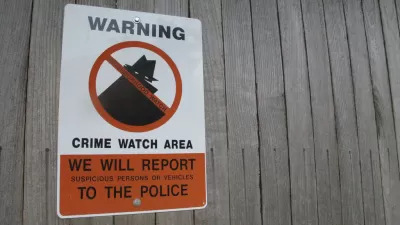Transit-oriented cities are safer than car-dependent cities of comparable size, especially if one considers traffic fatalities in car-dependent cities.

Some months ago, a blog post by Todd Litman pointed out that transit-oriented cities tend to have less overall crime. This post inspired me to address the relationship between big-city violence and big-city sprawl, but in a slightly different way.
First, I decided to focus on the crime most likely to be actually reported to police (that is, homicide), as opposed to lesser crimes which might inspire less police interest. Among the 30 largest U.S. cities, there are only six where public transit ridership is truly substantial (over 20 percent of commuters): New York, Philadelphia, Boston, Washington, Chicago, and San Francisco. In 20 cities, fewer than 10 percent of commuters used transit. In an "in-between" group of four cities (Baltimore, Portland, Seattle, Los Angeles) between 10 and 20 percent of commuters used transit.
The high-transit group's murder rates ranged between 5.1 per 100,000 residents (New York) and 21.5 per 100,000 (Philadelphia), with a median of 11.4.(1)
The medium-transit group's murder rates varied more widely, mainly because of the presence of Baltimore (34.9 murders per 100,000) in this group. Although this outlier inflates the group's mean homicide rate, its median homicide rate was only 5.7, lower than the high-transit cities.(2) Or to describe the situation another way, if we group the ten cities with transit modal shares over 10 percent, their collective median is 8.7 homicides per 100,000.
What about the low-transit group? The median homicide rate for the low-transit cities was 8.7(3)—exactly the same as the median for the cities with transit mode shares over 10 percent, though slightly lower than the median for the six most transit-oriented cities. Thus, it appears that there is not a significant difference in violent crime between the most car-dominated cities and more transit-oriented cities (especially since many of the "car cities," such as Houston, have annexed hundreds of square miles of suburban territory). Given the wide range of factors affecting crime rates, this lack of difference certainly accords with my common sense.
Second, I decided to focus on danger from cars as well as on danger from crime. In many cities, a stranger with a car creates far more risk than a stranger (or even a non-stranger) with a gun. For example, Austin's auto-crash fatality rate (6.4 per 100,000) is more than 60 percent higher than its murder rate (3.7).
Residents of more transit-oriented cities, by contrast, are at less risk from speeding cars. In particular, the nine most transit-oriented cities have a mean crash-fatality rate of 4.1 per 100,000, and a median crash-fatality rate of 4.0 (including both pedestrian and driver deaths).
How do the low-transit cities compare? Their mean fatality rate is 7.2 per 100,000 residents—about 75 percent higher than that of the more transit-oriented cities. (4) Similarly, their median fatality rate is 8.3—more than twice that of the more transit-oriented cities. To put the matter another way: only one of the "low transit" cities, San Jose, had a car death rate as low as the median for the more transit-oriented cities. Since cities built around the automobile tend to have lots of high-speed arterials (thus making accidents more likely to be fatal), this result too accords with common sense.
If one aggregates the homicide rate and the car-crash rate, we find that the cities with transit mode shares over 10 percent have a median "violent death" rate of 12.7 per 100,000, while the cities with lower transit mode shares have a median "violent death" rate of 17 per 100,000. So on balance, it does seem that the risk of violent death in car-oriented cities is higher than in transit-oriented cities.(5)
(1) homicide rates for other cities: Chicago 18.5, Washington 13.9, Boston 9, San Francisco 8.4. In this even-numbered group, I calculated the median by averaging the third most dangerous city (Washington) and the fourth most dangerous (Boston).
(2) homicide rates for other cities: Portland 3.3, Seattle 3.7, Los Angeles 7.8.
(3) homicide rates by city: Austin 3.7, Charlotte 6.4, Columbus 11, Dallas 12.4, Denver 6.2, Detroit 54.6, El Paso 3.4, Fort Worth 5.7, Houston 10, Indianapolis 11.6, Jacksonville 11.1, Las Vegas 5.1, Louisville 9.1, Memphis 20.2, Milwaukee 15.2, Nashville 10, Phoenix 8.3, San Antonio 6.4, San Diego 3.5, San Jose 4.6.
(4) City-by-city traffic death rates, as of 2011, are as follows: New York 2.8, Philadelphia 5.6, Boston 2.0, Washington 5.3, Chicago 4.3, San Francisco 3.6, Baltimore 4.0, Seattle 3.1, Portland 5.6, Austin 6.4, Charlotte 7.6, Columbus 7.0, Denver 5.2, Detroit 11.1, El Paso 10.5, Fort Worth 8.3, Houston 9.1, Jacksonville 9.6, Las Vegas 4.2, Memphis 11.3, Milwaukee 6.1, Phoenix 8.3, San Antonio 8.7, San Jose 3.6, Dallas 8.6. My primary source, City Data, did not have fatality rates for Los Angeles, as well as for three more car-oriented cities (Nashville, Louisville and Indianapolis).
(5) In addition, many homicides involve disputes between acquaintances, and thus involve little risk to the general public. If one assumes that half of homicides fall into this category, then the gap between the "high/medium transit" and "low transit" cities widens. But city-by-city data on the circumstances of homicides are pretty sparse, so I am not sure whether the data can support such assumptions.

Planetizen Federal Action Tracker
A weekly monitor of how Trump’s orders and actions are impacting planners and planning in America.

Maui's Vacation Rental Debate Turns Ugly
Verbal attacks, misinformation campaigns and fistfights plague a high-stakes debate to convert thousands of vacation rentals into long-term housing.

Restaurant Patios Were a Pandemic Win — Why Were They so Hard to Keep?
Social distancing requirements and changes in travel patterns prompted cities to pilot new uses for street and sidewalk space. Then it got complicated.

In California Battle of Housing vs. Environment, Housing Just Won
A new state law significantly limits the power of CEQA, an environmental review law that served as a powerful tool for blocking new development.

Boulder Eliminates Parking Minimums Citywide
Officials estimate the cost of building a single underground parking space at up to $100,000.

Orange County, Florida Adopts Largest US “Sprawl Repair” Code
The ‘Orange Code’ seeks to rectify decades of sprawl-inducing, car-oriented development.
Urban Design for Planners 1: Software Tools
This six-course series explores essential urban design concepts using open source software and equips planners with the tools they need to participate fully in the urban design process.
Planning for Universal Design
Learn the tools for implementing Universal Design in planning regulations.
Heyer Gruel & Associates PA
JM Goldson LLC
Custer County Colorado
City of Camden Redevelopment Agency
City of Astoria
Transportation Research & Education Center (TREC) at Portland State University
Jefferson Parish Government
Camden Redevelopment Agency
City of Claremont





























